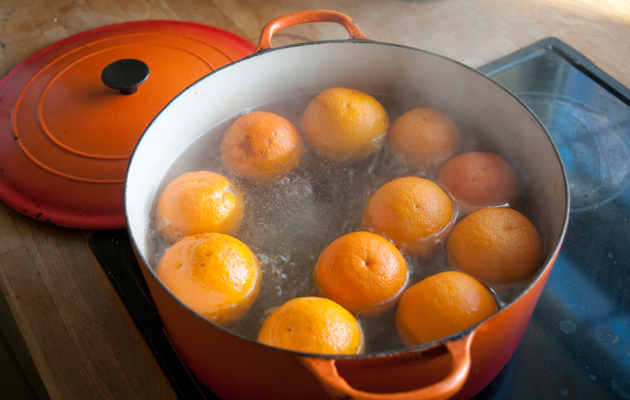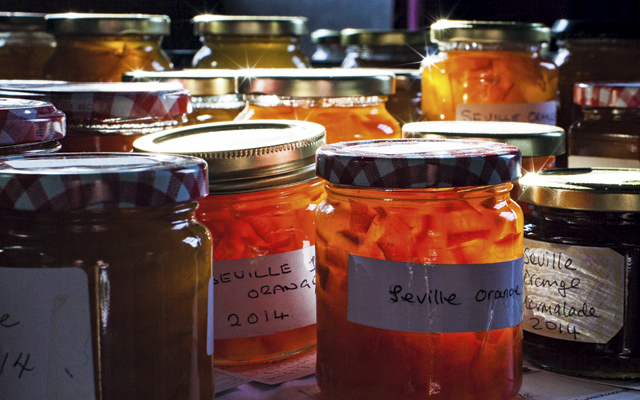Perfect Seville orange marmalade recipe
Make the most of the Seville orange season by following our delicious Seville orange marmalade recipe.


Renowned for their bitterness, and synonymous with conserves, the wonderful Seville orange has a painfully short shelf-life, only gracing the markets from December to February. With aliases such as 'sour orange' and (of course) 'marmalade orange', the brief appearance of the naval orange's acrid cousin calls for speedy action.
Making Britain's most popular breakfast-time preserve is obviously the fruit's top calling, but there are other uses for the dimple-skinned citrus. With it being a late-season fruit, the Seville is good for when the naval orange supplies are down and its added tanginess can be used in its favour. With a higher pectin content than the average sweet orange, it sets perfectly, hence why the Seville has been making radiant and chunky marmalades for centuries.
Below is a recipe for Seville Orange Marmalade so that you can line the pantry shelves while the rare fruit makes its cameo, but enjoy the bitter-sweetness throughout the year.
Seville Orange Marmalade
You will need: 450g Seville Oranges (juice and peel) 1 lemon (juice and peel) 3 pints water 650g granulated sugar 650g muscavado sugar Jam pan Hot sterile jars
Method Halve the oranges and lemon and squeeze the juice out of them. Put this aside. Keep all the pips from the juicer and tie loosely in a muslin bag (later add the pith).
Quarter the oranges and lemon skins and cut into fine threads, keeping the pith. Put the skin into a jam pan with the water and bag of pips and pith. Leave for a few hours, or overnight, if possible.
Sign up for the Country Life Newsletter
Exquisite houses, the beauty of Nature, and how to get the most from your life, straight to your inbox.
Put the jam pan to simmer over a low heat until the orange and lemon skin has become soft. Remove the bag of pips, squeezing (carefully, because it will be hot) to get all the pectin out of the seeds. (At this point, put three saucers into the freezer to be used later for testing setting point).
Add the sugar and fruit juices to the pan and simmer until all the sugar has dissolved and there are no remaining granules.
Raise the heat and boil the mixture rapidly, for approximately fifteen minutes. When it is beginning to thicken, remove from the heat and place a teaspoonful of the marmalade onto one of the chilled saucers. Put the saucer in the fridge to cool and then push the marmalade with your finger: it is set if a crinkly film is formed where you push it. If it hasn't set, return to the boil and re-check intermittently every 5 minutes.
When setting point is reached, allow the marmalade to cool slightly and thicken more. Stir to make sure the peel is evenly distributed before spooning into sterile jars (cleaned thoroughly and heated through in the oven for 10 minutes).
Another slightly richer option for the Seville fruit is to make curd. Much cloudier than a marmalade, a curd should have the consistency of clotted cream and is buffered against the sharpness of the citrus fruits it is best known to contain. In its effete thickness, it is the perfect tea-time treat!
This recipe combines Seville with the zest (and juice) of a sweet orange, too, to make it a bit less of a surprise kick to the palate. A bit of lemon juice is added for good measure.
Seville Orange Curd
You will need: 2 large sweet oranges (zest) 1 tbsp of the juice of the sweet orange 5 tbsp Seville orange juice 1 tbsp lemon juice 225g sugar 115g butter 2 eggs Containers to hold approximately 300g of curd
Method Put the rind (grated carefully to avoid the pith), juice, butter and sugar in a bowl, sat in a saucepan of water.
Turn on the hob and bring the water up to a gentle bubble, stirring the contents of the bowl until the sugar has dissolved.
Add the beaten eggs to the bowl and continue to stir. It may take up to half an hour for the curd to reach the consistency of custard. It is ready when the mix will stick to the back of a metal spoon.
Take off the heat, leave to cool slightly and then spoon into sterile containers. A lovely next step for the Seville Orange Curd (other than generously spreading onto hot English muffins) is to make a Seville Meringue Pie. On a rich, buttery pastry base, the slight tartness of the thick curd contrasts fantastically with a fluffy meringue top.
Seville Meringue Pie
You will need (for the pastry): 250g plain flour 50g icing sugar 150g cool butter, cut into cubes 2 eggs yolk 3tbsp milk (or a 500g pack of shop-bought short crust pastry)
You will need (for the meringues): 4 egg whites 200g caster sugar
Method: Sift the flour and sugar together and work the cubed butter into it, rubbing together, between your thumb and forefinger, until it has the consistency of breadcrumbs.
Add the egg yolks and milk to bind together, and roll into a doughy ball. Flour lightly, wrap in cling film and leave to stand in the fridge for half an hour.
Pre-heat the oven to 200 C.
Roll the pastry out on a floured surface and use to line a 25cm loose-bottomed tin. Prick the pastry with a fork, place a layer of grease-proof paper on top and line with baking beans. Bake for 12 minutes.
Meanwhile, whisk the egg whites in a very clean white bowl until forming stiff peaks. Then add the sugar, tablespoon by tablespoon, whisking until stiff and glossy.
Remove the pastry case from the oven and turn the heat down to 150 C, taking the beans and parchment paper out.
Pour the Seville Orange Curd (or spoon it) into the pastry case and then spoon the meringue mixture on top, using a fork to make swirls and peaks.
Pop into the oven and cook for about an hour, until the meringue has beautiful golden peaks.
With all these sweet treats in-store for the Seville oranges, there probably won't be room for savoury, but while the infrequent fruit are about, why not try Duck a la Seville Orange, too?
For more jam recipes and pictures, follow Katherine's blog: www.bejammed.wordpress.com

20 fascinating facts about marmalade
We bring you 20 fascinating facts about the sticky breakfast favourite.
Country Life is unlike any other magazine: the only glossy weekly on the newsstand and the only magazine that has been guest-edited by HRH The King not once, but twice. It is a celebration of modern rural life and all its diverse joys and pleasures — that was first published in Queen Victoria's Diamond Jubilee year. Our eclectic mixture of witty and informative content — from the most up-to-date property news and commentary and a coveted glimpse inside some of the UK's best houses and gardens, to gardening, the arts and interior design, written by experts in their field — still cannot be found in print or online, anywhere else.
-
 In all its glory: One of Britain’s most striking moth species could be making a comeback
In all its glory: One of Britain’s most striking moth species could be making a comebackThe Kentish glory moth has been absent from England and Wales for around 50 years.
By Jack Watkins
-
 Could Gruber's Antiques from Paddington 2 be your new Notting Hill home?
Could Gruber's Antiques from Paddington 2 be your new Notting Hill home?It was the home of Mr Gruber and his antiques in the film, but in the real world, Alice's Antiques could be yours.
By James Fisher